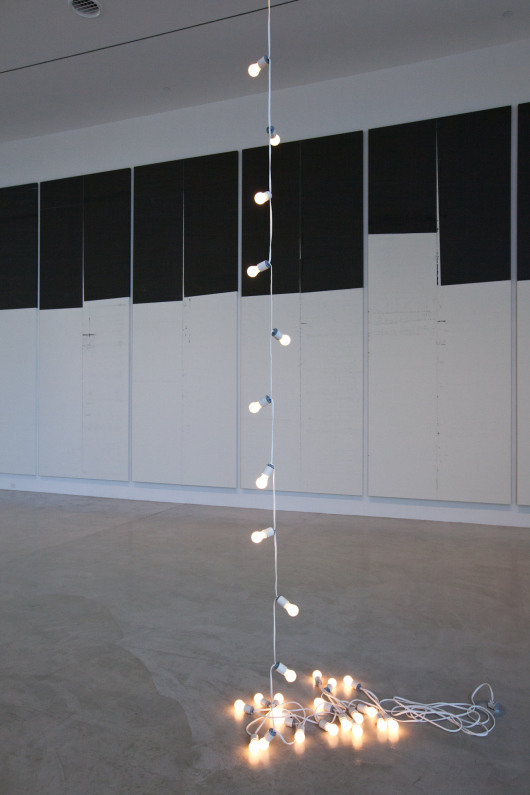
Talking about the life and art of Felix Gonzalez-Torres
It was appropriate that as the audience streamed in to take their seats at the de la Cruz Collection on Thursday night, they would pass by the lovely light sculpture by Felix Gonzalez-Torres hanging from the ceiling and pooling on the floor, in front of the black-and-white linen painting from Wade Guyton.
They were coming to hear a lecture from artist Cesar Trasobares, the last of a series of three where Trasobares talked about the art, and his own history with three of the most important contemporary Cuban-American artists: Ana Mendieta, Carlos Alfonzo, and for this last lecture, Felix Gonzalez-Torres. Elements of these lectures will make up part of Trasobares’s upcoming book, “Among Friends.”
These are important for Miami. Our end of the U.S. peninsula is slowly but surely growing its own, unique history. Trasobares, who also has art work in the de la Cruz Collection, is telling his stories and at the same time linking Florida to significant trends in art and culture. All three of the artists he is talking and writing about are dead – all died in the prime of their lives while having already left ground-breaking trails. This night, the crowd packed in to hear about Gonzalez-Torres, who is mostly known for his minimalist and fluid sculptures.
Gonzalez-Torres light sculpture on ground floor at the de la Cruz Collection.
For instance, in various exhibits at the de la Cruzes’, one can see his famous paper-stack sculpture; same-size white sheets of paper, with “Somewhere better than this place/No where better than this place” written on them, are stacked on the floor, and visitors are encouraged to take one. It will be stacked to its original size at the end of the day. Same with his candy sculptures, colorfully wrapped candies piled up against the wall. In one case the starting weight of the sculpture is 174 pounds, the weight of Gonzalez-Torres’s partner before he started losing weight and dying of AIDS. As people take the candy the sculpture’s weight is similarly reduced (but is replenished again for the next installation, in a cycle of rejuvenation). Gonzalez-Torres also lost the fight against AIDS, which informed much of his work towards the end of his life.
He was born in Cuba in 1957 and sent to Madrid with his sister in the early 1970s. He would move to Puerto Rico and finally New York, and his work would be shown internationally in major museums and exhibits. Trasobares put up numerous snapshots of the artist’s work and of his personal life, in his home, with his cats, both touching and everyday prosaic. Unfortunately the room was big and filled, so at times the sound system did not do justice and some of the anecdotes were hard to hear. We’ll have to wait for the book.
Gonzalez-Torres died in 1996 (in Miami), but was one of only two American artists to be posthumously selected to represent the U.S. at the Venice Biennale, in his case in 2007. Trasobares and the de la Cruzes are doing a fine job of not letting this notable legacy die.
de la Cruz Collection Contemporary Art Space: 23 N.E. 41st St., Miami; 305-576-6112; www.delacruzcollection.com
Recent Content
-
Artsarticle ·
-
Artsarticle ·
-
Artsarticle ·

